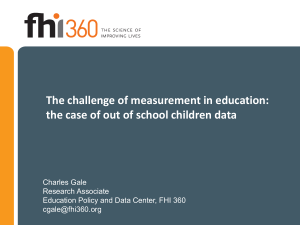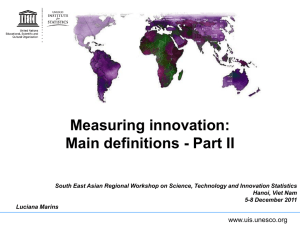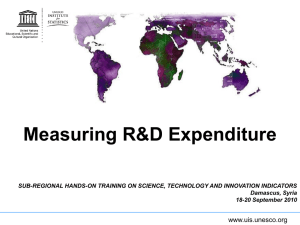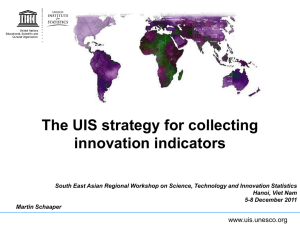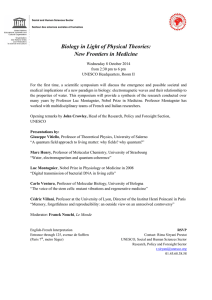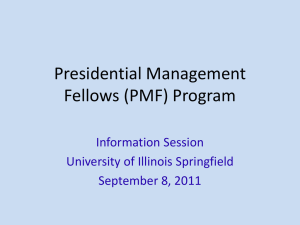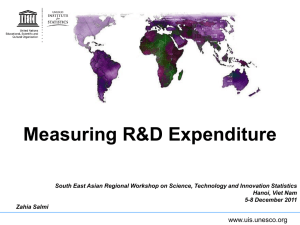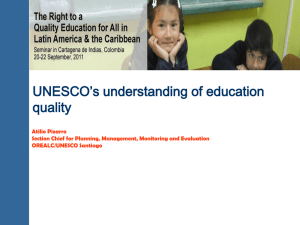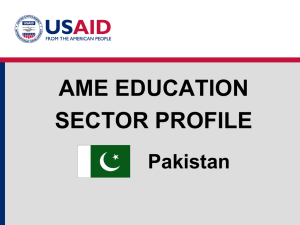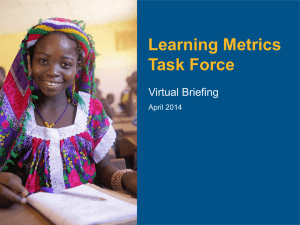Measuring Research and Experimental Development
advertisement
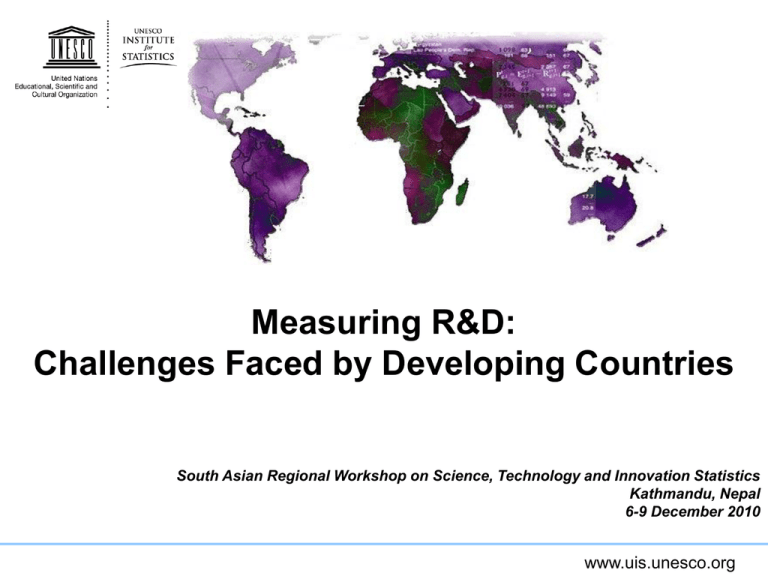
Measuring R&D: Challenges Faced by Developing Countries South Asian Regional Workshop on Science, Technology and Innovation Statistics Kathmandu, Nepal 6-9 December 2010 www.uis.unesco.org Outline The problem The process Contents of the Technical Guide Thinking ahead www.uis.unesco.org R&D statistics in developing countries (1) Recognition, meeting targets, evidence-based S&T policy, but: • lack of interest at the level of policy makers (low policyrelevance?) • S&T is still not properly represented in economic/social public policies. lack of resources devoted to statistics in S&T • lack of technical knowledge for the production of crossnationally comparable R&D statistics • weak statistical institutions • difficulties in applying FM concepts and methods www.uis.unesco.org R&D statistics in developing countries (2) Particular characteristics of R&D activities to be taken into account: • R&D performers function within the specific context of a national, cultural, political, financial and economic system • different structures in terms of government, innovation system, higher education system, statistical system • particular ‘culture of information’ • Users of R&D stat: Gov, analysts. + international donor agencies S&T indicators • adapted to particular policy needs • provide answers to actual policy questions However, international comparability is foremost www.uis.unesco.org The process Process started in 2007 Lead papers by consultants Meetings in 2007 and 2009 Experience acquired through the UIS work Proposal for an annex to the Frascati Manual at the OECD 2008 and 2009 NESTI meetings; accepted at 2010 meeting Technical Guide released in English • Translations in Spanish and French almost finished www.uis.unesco.org Products www.uis.unesco.org Contents of the Technical Guide 1. Introduction 2. The nature of R&D activity in developing countries 3. R&D expenditure 4. Internal and international mobility of the R&D workforce 5. Specific fields of R&D activity 6. Foreign and internationally controlled entities 7. Strengthening R&D statistical systems 8. Thinking ahead www.uis.unesco.org Chapter 2: The nature of R&D activity in developing countries The growing importance of R&D • More ‘R’ than ‘D’ in developing countries. • Strong presence of the government and higher education sectors in the performance of R&D. Lower emphasis on R&D in business sector. • Occasional R&D / Informal R&D • Special types of R&D www.uis.unesco.org Chapter 2: The nature of R&D activity in developing countries cont… Heterogeneity and concentration • Developing countries are a heterogeneous group: » Group A: countries with consolidated R&D systems and developed S&T statistics systems no major difficulties in applying Frascati Manual concepts. » Group B: countries with consolidated R&D systems and less developed S&T statistics systems need specific guidance on how to establish and consolidate sound R&D statistics systems. » Group C: countries with incipient R&D systems need specific guidelines on how to start creating a regular R&D statistical collection. • High degree of concentration (in group of countries, in particular institutions, in major projects, etc) lead to volatility and inconsistencies in statistics. www.uis.unesco.org Chapter 3: R&D expenditure Use of secondary data from national budget New sources of funds emerging Discrepancy between voted and allocated budget Budgetary commitments are not followed up Mixing of budgetary records and annual reports from performing units Definition of S&T / R&D budgets Identifying R&D components in the national budget State-owned enterprises, university-owned companies and national scientific academies Private universities Fiscal year vs. calendar year Information systems in government and higher education inadequate for statistics www.uis.unesco.org Chapter 4: Internal and international mobility of the R&D workforce Underestimation of researchers Unpaid research Informal research Research outside of the normal work setting with external funding Multiple part time positions not taken into account or undercounted Master’s research www.uis.unesco.org Counting researchers Overestimation of researchers Counting the contract instead of the real effort Multiple full-time research positions www.uis.unesco.org Counting researchers Special cases FTE calculation >1 and FTE>HC R&D in times of crisis Visiting researchers Brain circulation www.uis.unesco.org Counting researchers Recommendations Peer interviews of researchers Include a module on barriers Use secondary sources • Publication databases, both national and international • STMIS and other databases of researchers • Databases and registers of clinical trials • Databases and registers of the main foreign donors involved in funding R&D in the countries • University accreditation databases www.uis.unesco.org Chapter 5: Specific fields of R&D activity Traditional knowledge Clinical trials Industrial activities Other activities www.uis.unesco.org Special types of R&D - Traditional knowledge Traditional knowledge (TK) A cumulative body of knowledge, know-how, practices and representations maintained and developed by peoples with extended histories of interaction with the natural environment. These sophisticated sets of understandings, interpretations and meanings are part and parcel of a cultural complex that encompasses language, naming and classification systems, resource use practices, ritual, spirituality and worldview. www.uis.unesco.org Special types of R&D - Traditional knowledge Dichotomy between traditional and scientific knowledge systems substantive grounds – because of differences in the subject matter and characteristics of traditional and scientific knowledge methodological and epistemological grounds – because the two forms of knowledge employ different methods to investigate reality contextual grounds – because traditional knowledge is more deeply rooted in its environment www.uis.unesco.org Special types of R&D - Traditional knowledge Links between traditional and scientific knowledge systems Scientific approach to TK (in ethno-botany, ethnopedology, ethno-forestry, ethno-veterinary medicine, ethnoecology, etc). The application of scientific methods to TK, converting it into a source of scientific information. (in biodiversity science or nature conservation; traditional health and pharmacopeia). Interaction between scientists and communities in participatory technology development www.uis.unesco.org Special types of R&D - Traditional knowledge Measurement issues and recommendations Establish the boundaries for TK (what qualify as R&D) The activities establishing an interface between traditional knowledge and R&D Some fields of activities in TK are transdisciplinary (e.g. ethno-botany), making them extremely difficult to map into the current classification’s structure. www.uis.unesco.org Special types of R&D - Clinical trials Clinical trials (Can) involve a significant amount of R&D Need to be conducted on a wide population Growth area for developing countries www.uis.unesco.org Special types of R&D - Clinical trials Measurement of clinical trials Registers of clinical trials available, e.g. WHO but also national Funding often from abroad Performance various possibilities • a local branch of the foreign main sponsor • universities and university hospitals • individual researchers • local medical clinics • locally registered PNPs • international PNPs www.uis.unesco.org Special types of R&D - Clinical trials Measurement issues and recommendations Occupation category of local staff • Medical doctors and other professionals with at least ISCED 5A degrees should be considered as researchers • Nurses and other staff with qualifications below ISCED 5A should be accounted for as technicians FTE calculation is important (often part-time) Attribution of sector of performance must be done with care to avoid double counting www.uis.unesco.org Special types of R&D - Industrial activities Reverse engineering: understanding the structure and functioning of an object (in order to make a new device or program creates a similar object in a different way), copying it, or improving it. Recommendation: If reverse engineering is carried out in the framework of an R&D project to develop a new (and different) product, it should be considered as R&D. www.uis.unesco.org Special types of R&D - Other activities Community development and other social projects • R&D only in development and testing phase experimental development (most probably in the field of social sciences) Religious research • part of humanities, • should be included in R&D surveys. This (religious research) will not be a recommendation www.uis.unesco.org Chapter 6: Foreign and internationally controlled entities Foreign antennas Foreign company’s R&D labs International organizations operating in the country Foreign universities based and conducting R&D in campuses set up in the country www.uis.unesco.org The foreign institutions sector Recommendation Create a “foreign institutions” (FI) sector as a separate sector of performance Funding flowing from this sector to other sectors should be considered from “Abroad” as stated in the main body of the Frascati Manual What is included? • Foreign antennas • International organizations • Foreign company’s R&D labs (remains in the business sector) • Foreign universities (remains in the HE sector) www.uis.unesco.org The foreign institutions sector The principal sector sub-classification Business enterprises Government Higher Education Private non-profit International organizations www.uis.unesco.org Chapter 7: Strategies for setting up S&T statistics systems in developing countries Will be discussed in session 8. www.uis.unesco.org Chapter 8: Thinking ahead: Other products – beyond R&D Redefine the concepts of scientific and technological education and training at broadly the third level (STET), Scientific and technological services (STS) and S&T activities (STA) Better integrate education statistics with R&D statistics Hands on guidance Metadata Model questionnaire www.uis.unesco.org Thank you! http://www.uis.unesco.org m.schaaper@uis.unesco.org www.uis.unesco.org

